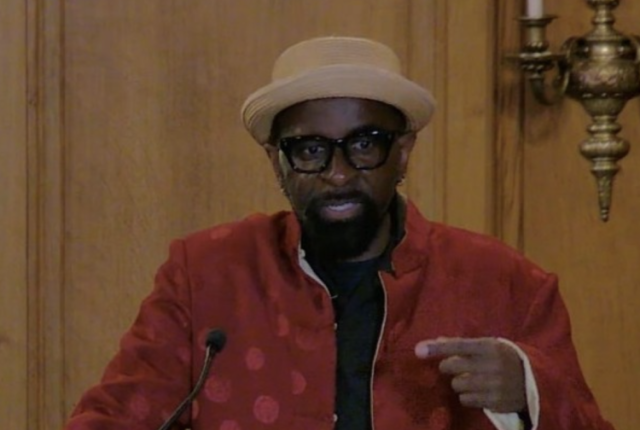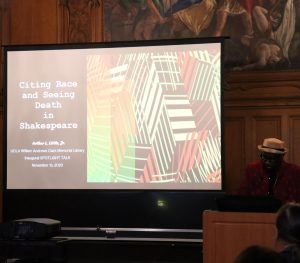
 On November 15, 2023, I had the pleasure of being in attendance at Arthur L. Little, Jr.’s “Citing Race and Seeing Death in Shakespeare,” the inaugural talk in The Clark Memorial Library’s Spotlight Talk series. Dr. Little’s presentation, which begins with Ben Jonson’s reading of Shakespeare in the First Folio and concludes with a careful analysis of the iconic film still of Laurence Olivier in the graveyard scene in Hamlet (1948), examines the degrees to which the Shakespearean property has been instrumental in the ongoing construction of a white liberal humanities –– an educational apparatus instrumental in denying populations both their liberty and their humanity. Dr. Little asserts that a “humanities outside the provinciality of a white humanities” is possible to attain, so long as we are able to collectively “break up with the fetishization of history as an immutable, foregone construct that allows us to abdicate our ethical responsibilities as critics, scholars, teachers, and students. It requires us to break up with whiteness.”
On November 15, 2023, I had the pleasure of being in attendance at Arthur L. Little, Jr.’s “Citing Race and Seeing Death in Shakespeare,” the inaugural talk in The Clark Memorial Library’s Spotlight Talk series. Dr. Little’s presentation, which begins with Ben Jonson’s reading of Shakespeare in the First Folio and concludes with a careful analysis of the iconic film still of Laurence Olivier in the graveyard scene in Hamlet (1948), examines the degrees to which the Shakespearean property has been instrumental in the ongoing construction of a white liberal humanities –– an educational apparatus instrumental in denying populations both their liberty and their humanity. Dr. Little asserts that a “humanities outside the provinciality of a white humanities” is possible to attain, so long as we are able to collectively “break up with the fetishization of history as an immutable, foregone construct that allows us to abdicate our ethical responsibilities as critics, scholars, teachers, and students. It requires us to break up with whiteness.”
This call to both elucidate Shakespeare’s role as “the corner-stone of cultural discipline,” as Joseph Quincy Adams states in the inaugural address of the Folger Shakespeare Library (1932), and to emancipate the property from this hegemonic disciplinary network is particularly useful for my research, which focuses on early modern race, critical whiteness studies, the concept of the human, and necropolitics. Dr. Little’s talk synthesizes each of these subjects within his analysis of Shakespeare’s invocations of Black life as what Giorgio Agamben terms bare life. Whether it’s the “rich jewel in an Ethiop’s ear” from Romeo and Juliet or Lysander’s dismissal of Hermia through referring to her as a “tawny Tartar” in A Midsummer Night’s Dream, Black bodies and persons are seen and cited as perpetually inanimate objects to both formulate white aesthetics and affirm white subjectivity.
This near-Hegelian dialectic of white subjecthood and Black objecthood is, perhaps, best articulated by Olivier in his memoir, Confessions of an Actor (1982). In it, as Dr. Little notes, the actor describes himself as “not being white enough” to embody the role of Hamlet; in contradistinction, Olivier seems to suggest he exceeds the qualifications to take on the role of the eponymous Moor of Venice in Othello (1965). Continuing the legacy of early modern minstrelsy through racial prosthesis –– that is, the ways in which white male actors were able to animate these so-called “Black” bodies onstage –– Olivier recounts the materials and techniques used for his blackface performance: “Black all over my body, Max Factor 2880, then a lighter brown, then Negro Number 2, a stronger brown. Brown on black to give a rich mahogany. Then the great trick: that glorious half yard of chiffon with which I polished myself all over until I shone … The lips blueberry, the tight curled wig, the white of the eyes, whiter than ever, and the black, black sheen that covered my flesh and bones, glistening in the dressing room lights.” This graphic fetishization of the performance process and subsequent reduction of blackness to bare life –– a thingness best expressed through Prospero’s disparagement of Caliban as a “thing of darkness” in The Tempest –– substantiates Dr. Little’s claim as to how the pornotroping of Black bodies has been made requisite for the white humanities and, indeed, the white human to take shape. If Shakespeare studies, and the humanities more broadly, hope to make space for more diverse populations, it is imperative to wake up from the racial fantasy and break up with whiteness.
-Jonathan Van Niel, Doctoral Candidate, Department of English

